
The best online fitness resource you'll ever need. We filter out the BS to ensure you meet your health and fitness goals!

The best online fitness resource you'll ever need. We filter out the BS to ensure you meet your health and fitness goals!
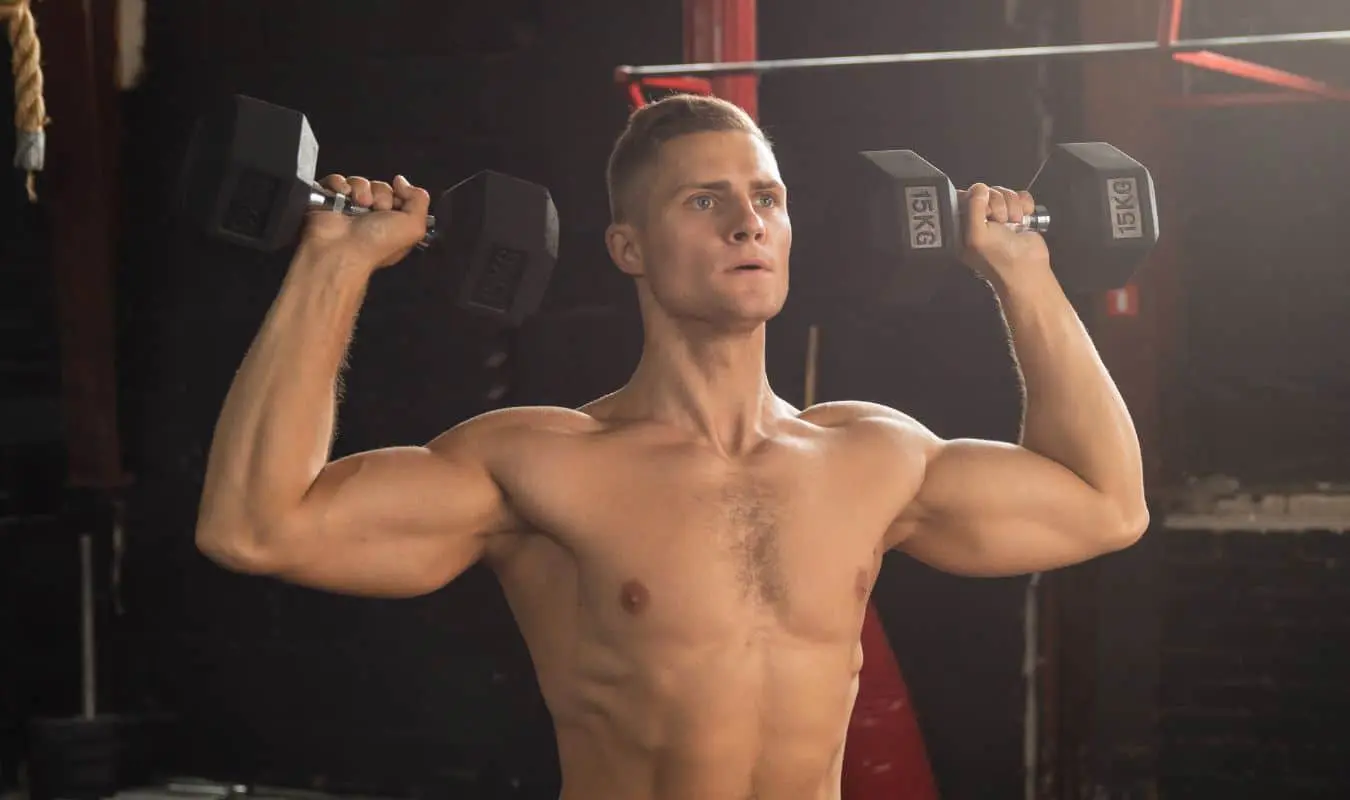
Nothing says ‘strong and athletic’ quite like a pair of muscular, round shoulders and a thick upper back.
While some are lucky enough to have genetics on their side, allowing them to build impressive shoulders with minimal effort, others—like me—need a well-thought-out plan and consistent hard work to achieve that coveted thick, rounded look.
This Shoulder Workout Plan is designed to do just that, giving you the tools and structure needed to build the powerful shoulders you’ve always wanted.
Jump to the workout plan now!
Alternatively, you can download the free PDF version of the routine using the link below:
| Program style | Bodybuilding |
| Workout duration | 1 hour |
| Scheduling | 1 day a week, can incorporate into other programs |
| Goal | Build shoulders |
| Level | Beginners to advanced |
| Target Gender | Male and Female |
To begin with, this is a bodybuilding type program.
It’s crafted to build aesthetically excellent, larger, thicker shoulder muscles.
It is NOT a strength program. Nor is it a functional fitness program nor a calorie burning-get shredded program.
For strength try: The Ultimate 12 Week Strength Training Program
If you follow it, your shoulders will grow and improve their shape, to the degree your genetics will allow.
Why am I so confident?
The program you’ll read about here–and maybe download…we hope so–has been crafted over a period of months.
You can do this program in a garage gym. You cannot do it with a small home gym with only a few dumbbells or bands.
The program will serve you best if you train in a fully-equipped gym.
I’ve noted preferred exercises in the program. While several gym implements will work just fine, the ones that add stability will allow you to focus on the shoulders without devoting thought or energy to supporting the rest of the body.
Remember: this is not a functional fitness program. It pays no attention to working the stabilizer muscles.
Try our popular functional program: The Ultimate 12 Week CrossFit Program (Free PDF)
This Shoulder workout routine is split into an A and B section.
You can do the whole thing in one workout, or split it up.
Beginners should concentrate on Shoulder A. It’s only 3 exercises, which may seem like not much.
Be patient. Do these, do them well, and then add Shoulder B once you’ve adapted and seen some progress.
Beginners stick to Shoulder A until you plateau and notice your gains stalling. It’s just 3 exercises and if you do them right, you’ll see results.
If this is your first bodybuilding style routine–meaning you’ve previously been doing functional workouts or CrossFit – start with the Beginner version. Take a week or two off from training your upper body before you start this routine.
Progress assumes you’re getting enough rest and getting the right nutrition.
Not going to dive deep into nutrition here other than to say eat a balanced diet and get enough high quality protein to support muscle growth.
Do all the exercises in Shoulder A and Shoulder B, suggesting the following split:
Bro (bodypart) Splits: Combine Shoulder A and B.
For Upper-Lower Splits: Combine Shoulder A and B into an Upper body day. In that format, I would personally use a combined Shoulder A-B workout in an Upper A – Upper B format, where shoulder day was one of the upper body days all its own.
I’ll show you exactly how to do this later in this piece using our 4 Day Upper Lower Split Workout Plan.
For Push Pull Legs Splits: segment the pushing motions into your Push day of choice. Same for the pulling motions into Pull days. Anterior and Middle deltoid exercises such as side laterals logically go into Push days, and Posterior deltoid exercises and rows would move to Pull days.
Check out the Application Notes below for specifics.
The program you’ll find here may not look like a lot of workout volume. The data now suggest that fewer, more intense sets are best for muscular hypertrophy.
So if it’s bigger, thicker shoulders you’re looking for, give this workout an honest try.
Do it for a minimum of 12 weeks.
Rep schemes are probably lower than you may be used to. Hey, I was a high-rep guy for years.
But after reading the research, talking to people better than me, and doing some solid experimentation in the gym, I’m convinced that the lower rep ranges are better for size and definition.
| Exercise | Set 1 | Set 2 | Set 3 | Set 4 |
|---|---|---|---|---|
| High Incline Shoulder Press | 12-15 | 8-10 | 6-8 | 6-8 |
| Lateral Raises | 12-15 | 8-10 | 6-8 | 6-8 |
| Seated “High” Row, elbows up | 12-15 | 8-10 | 6-8 | 6-8 |
| Exercise | Set 1 | Set 2 | Set 3 | Set 4 |
|---|---|---|---|---|
| Thumbs Up Front Raises | 12-15 | 8-10 | 6-8 | 6-8 |
| Upright Row | 12-15 | 8-10 | 6-8 | 6-8 |
| Rear Delt Flyes | 12-15 | 8-10 | 6-8 | 6-8 |
| Barbell Plate Raises or Dumbbell “I” or “Y” Raises | 12-15 | 8-10 | 6-8 | 6-8 |
We’ve got an Upper-Lower split routine that you can easily add this Shoulder routine to. It’s actually the split I use to great effect.
It’s got 2 Upper days and 2 Lower days, which allows me to work in several favorite exercises that are working for me that I don’t want to perform during the same workout for recovery reasons. So I spread them out.
The Shoulder Workout also has an A and a B day. That split is also for recovery purposes. The split between the 2 days follows the same logic: One day leans in on the anterior movers, and the other biases posterior a little more. Again…for recovery reasons. (You can’t grow if you can’t recover between workouts.)
Here’s how I’d add the Shoulder focused workout to the Upper-Lower Split. I’ve done this myself because my shoulders are an area of focus for me right now.
Why?
Lats have always come easy for me due to my genetics. By contrast, my shoulder muscles do not. I know why, but it’s too complicated to explain here. Regardless, I work extra hard on shoulders.
The High Incline Press and Lateral Raises are already in my Upper A day. So that’s the easy part.
Now, let’s add the Seated “High” Rows.
This “High” version with elbows flared is intended to work the posterior delts and other adjacent shoulder extensors.
I would personally stick the high rows after Lateral Raises. You could opt to do them before. Sometimes, I’ll change the order of my exercises if the equipment I want isn’t available, like during busy gym times. Don’t overthink this stuff.
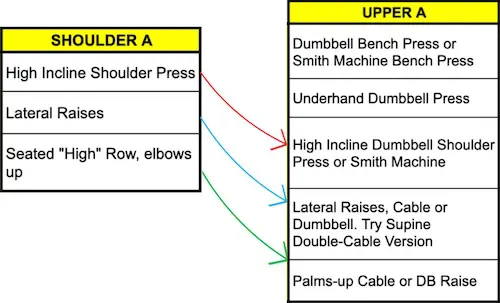
So it should end up looking like:
| Exercise |
|---|
| Dumbbell Bench Press or Smith Machine Bench Press |
| Underhand Dumbbell Press |
| High Incline Shoulder Press |
| Lateral Raises |
| Seated “High” Row, elbows up |
| Palms-up Cable or DB Raise |
So there you go. You’ve added a shoulder focus to your upper-lower split. Do this if shoulders are an area you need to build.
Now let’s incorporate Shoulder B into our Upper-Lower split.
You could put the Thumbs Up Front Raises after Kelso Shrugs. Kelsos done right are strenuous. They work the comparatively larger middle and lower traps thereby requiring a lot of energy; the anterior delts not so much. So personally, I’d move the Thumbs-Up Front Raises to the very end.
It’s important to do Front Raises with the thumbs up, or even palms up. Unless you do this, the deltoids will work exactly the same as they do for side laterals. The muscle will not sense the difference. Thumbs up and palms up orients the anterior delts directly against resistance.
Upright Rows? I could see doing those either before or after Kelsos. Personally–based on my goals right now–I’d do them before.
I’ve found Upright Rows to be a beneficial compound movement for middle delts and middle traps…the portion of the traps that create that “yoked” look. So stick those before or after Kelsos, your choice.
Rear Delt Flyes are already in the Upper B split, so that’s easy. They’re called Reverse Flyes in the Upper-Lower routine. Same beast.
Barbell Plate Raises, “I” and “Y” Raises work the same muscles as Lu Raises, for the most part. Lu Raises don’t involve the low-middle and lower traps as much as “I” or “Y” Raises. So if you’re focused on building a beefy middle back, stick to the “I” or “Y” raises.
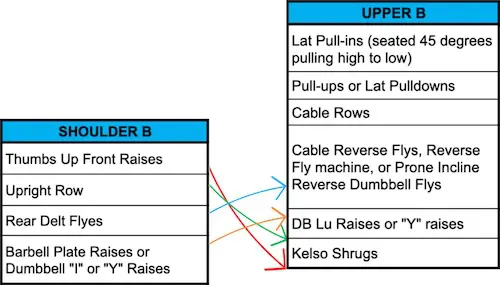
And it should end up looking like this:
| Exercise |
|---|
| Lat Pull-ins (seated 45 degrees pulling high to low) |
| Pull-ups or Lat Pulldowns |
| Cable Rows |
| Rear Delt Flyes |
| Barbell Plate Raises or Dumbbell “I” or “Y” Raises |
| Upright Row |
| Kelso Shrugs |
| Thumbs Up Front Raises |
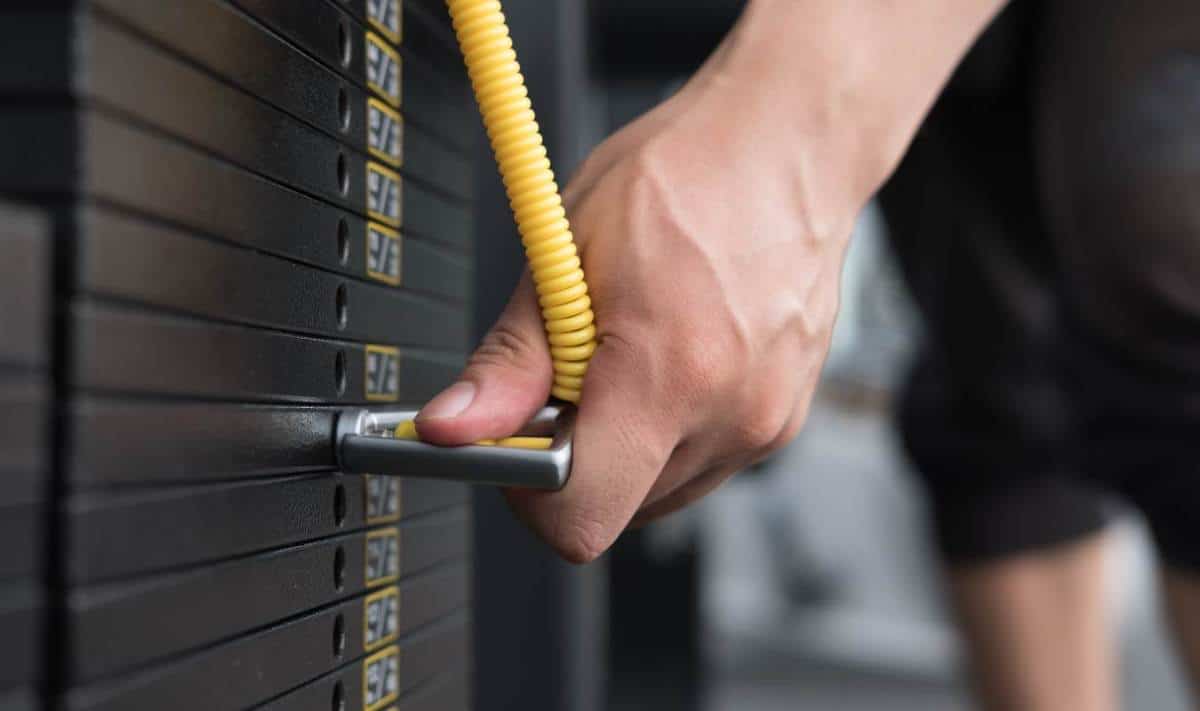
Apply progressive overload.
Once you can do the specified number of reps at your selected weight, raise the weight so that you’re back at the bottom end of the rep range again.
Repeat.
The last reps of the last 2 sets should be difficult. Do not sacrifice form.
Because the shoulder is such a complex body part, it’s possible to give special attention to a specific region of it that needs it.
As we critically assess our own physiques, we can see that one part of a single muscle needs more development. Maybe width is the issue. If so, get after the middle deltoids. Maybe it’s thickness. OK, get after the posterior delts and maybe a big compound movement like the high incline press.
You get my point.
I’ve designated each exercise with its focus muscle region.
For me, my anterior and posterior deltoids need the most attention. My posterior delts need heavier load right now, so I’m doubling down on the elbows-up rows and machine reverse flyes these days as opposed to cable reverse flyes.
I’m getting results from heavy high incline presses for my anterior delts, and lighter anterior front raises. I’ve got recurrent tendon inflammation that sidelines me if I’m not careful with the anterior delt movements.
So…
If you’re an experienced lifter, feel free to cherry pick exercises that are specific to what you’re trying to develop.
Shoulders are just not my strong suit but these exercises have helped me.
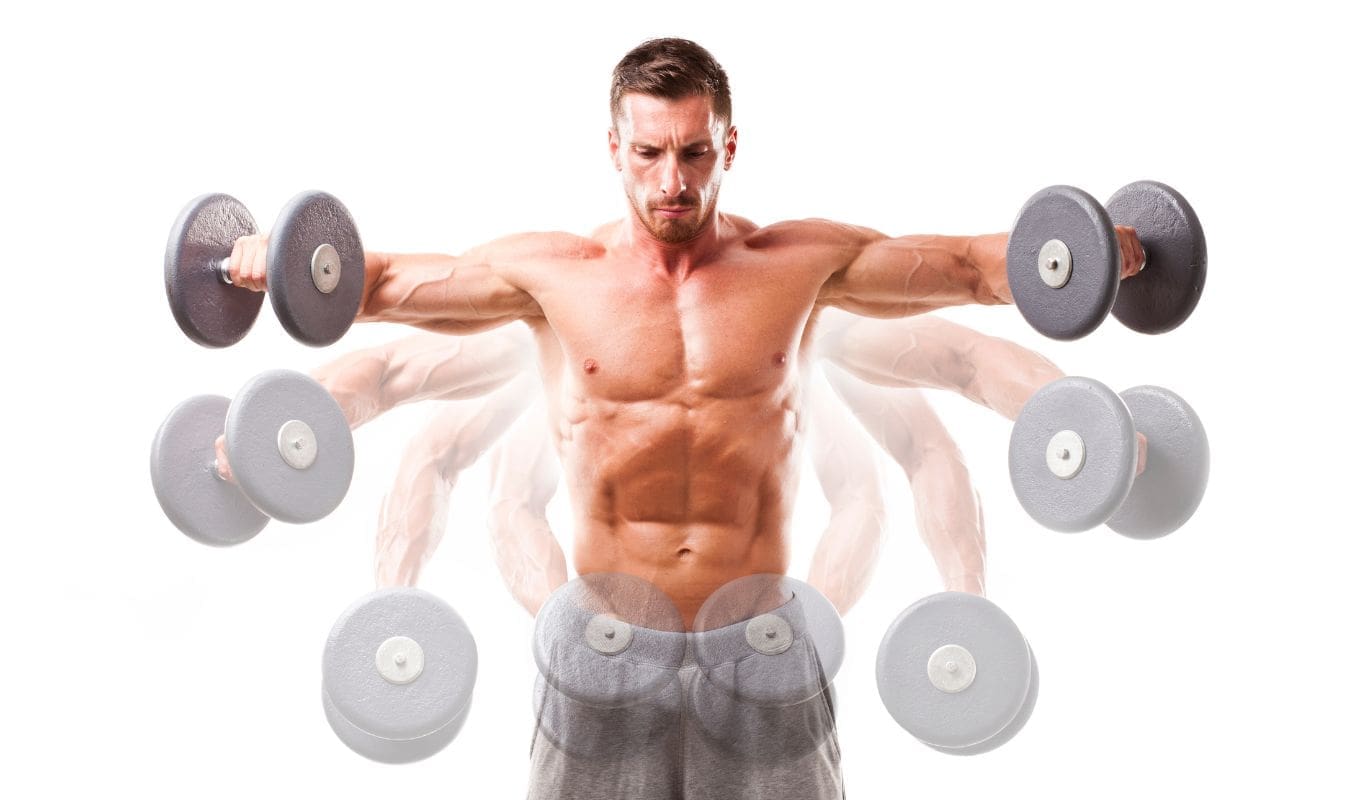
Strict reps only. Concentrate on the downward, eccentric portion of the movement but don’t count…unless it helps you concentrate. These are not timed reps.
The reps in the working sets are going to go up really slowly if you’re doing the right amount of weight.
I’m never surprised when my final reps take 4 to 5 seconds to go from bottom to top, grinding the entire way.

Shoot for three minutes between each of the last 2 sets of each exercise. For earlier, warm-up sets, less is OK.
Use your rest time between sets productively. Dial in. Analyze the set you just finished. Ask:
Then, visualize your next set.
Leave your phone in your locker or bag.
Download our Shoulder Workout Plan PDF below:
We write custom programs. If you have specific physique goals–such as “I’d like wider shoulders”, or “I’d like more ‘V’ in my back”–we can write one for you. Reply in the Comments or simply contact us and we’ll get back in touch. First come, first served.